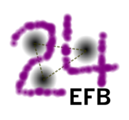Speaker
Description
The nature of the recently discovered $Z_c$ and $Z_b$ structures is intriguing. On the one hand, in the charm sector, the $Z_{c}(3900)^\pm$ and $Z_{c}(4020)^\pm$ were discovered in the $\pi J/\psi$ and $D^\ast\bar D^{(\ast)}+h.c.$ invariant mass spectra. Their nature is puzzling due to their charge, which forces its minimal quark content to be $c\bar c u\bar d$ ($c\bar c d\bar u$). Additionally, their strong coupling to channels such as $\pi J/\psi$ and the closeness of their mass to $D^\ast\bar D^{(\ast)}$-thresholds stimulates both a molecular interpretation or a coupled-channels threshold effect. On the other hand, in the bottom sector, the well-established $Z_{b}(10610)$ and $Z_{b}(10650)$ states couple to $B^{(\ast)}B^{\ast}$-channels and are heavy enough to assume that they should contain a constituent $b\bar{b}$-pair. Moreover, they are charged and hence they must also have another constituent light quark-antiquark pair, namely $u\bar{d}$ $(Z_{b}^{+})$. Their minimal structure would be then $b\bar{b}u\bar{d}$, which automatically qualifies them as an (exotic) bottomonium-like meson. Thus, in all cases, it is necessary to explore four-quark systems in order to understand their inner structure.
In this work we perform a coupled-channels calculation of the $I^G(J^{PC})=1^+(1^{+-})$ charm and bottom sectors in the framework of a constituent quark model [1,2] which satisfactorily describes a wide range of properties of (non-)conventional hadrons containing heavy quarks [3]. All the relevant channels are included for each sector: The $D^{(\ast)}\bar D^{\ast}+h.c.$, $\pi J/\psi$ and $\rho\eta_c$ channels for the $Z_c$ [4] and $B^{(\ast)}B^{\ast}$ and $\Upsilon(nS)\pi$ ($n=1,2,3$) channels for the $Z_b$ analysis. Results will be discussed.
[1] J. Vijande, F. Fern\'andez and A. Valcarce, J. Phys. G31, 481 (2005).
[2] J. Segovia, P. G. Ortega, D. R. Entem and F. Fern\'andez, Phys. Rev. D93,
074027 (2016).
[3] P. G. Ortega, D. R. Entem and F. Fern\'andez, J. Phys. G40, 065107 (2013).
[4] P. G. Ortega, J. Segovia, D. R. Entem and F. Fern\'andez, Eur. Phys. Jour. C 79:78 (2019).

